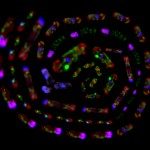Link to Pubmed [PMID] – 12581639
J. Mol. Biol. 2003 Feb;326(3):769-82
CAG/CTG trinucleotide repeat tracts expand and contract at a high rate during gene conversion in Saccharomyces cerevisiae. In order to characterize the mechanism responsible for such rearrangements, we built an experimental system based on the use of the rare cutter endonuclease I-SceI, to study the fate of trinucleotide repeat tracts during meiotic or mitotic (allelic or ectopic) gene conversion. After double-strand break (DSB) induced meiotic recombination, (CAG)(98) and (CAG)(255) are rearranged in 5% and 52% of the gene conversions, respectively, with similar proportions of contractions and expansions. No evidence of a meiotic hot spot activity associated with trinucleotide repeats could be found. When gene conversion is induced by a DSB during mitotic growth of the cells, no rearrangement of the repeat tracts is detected when the donor sequence is allelic to the recipient site of the DSB. However, when the donor sequence is at an ectopic location, frequent contractions and expansions of the repeat tract are found. No crossing-over associated with gene conversion could be detected. Mutants for the MUS81 gene, involved in the resolution of recombination intermediates, show a frequency of rearrangements identical with that of the wild-type strain. We concluded that trinucleotide repeat rearrangements occur frequently during ectopic but not during allelic recombination, by a mechanism that does not require crossover formation.

